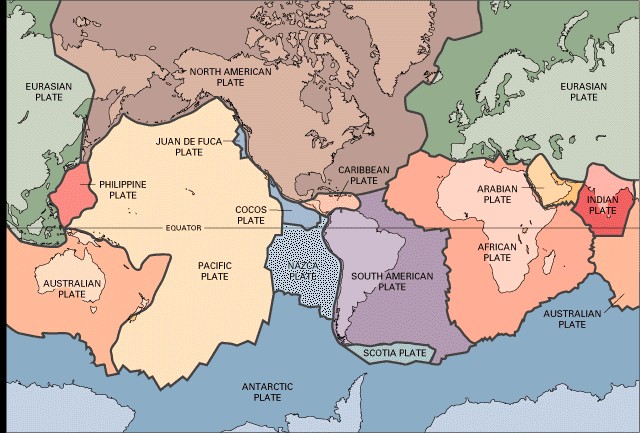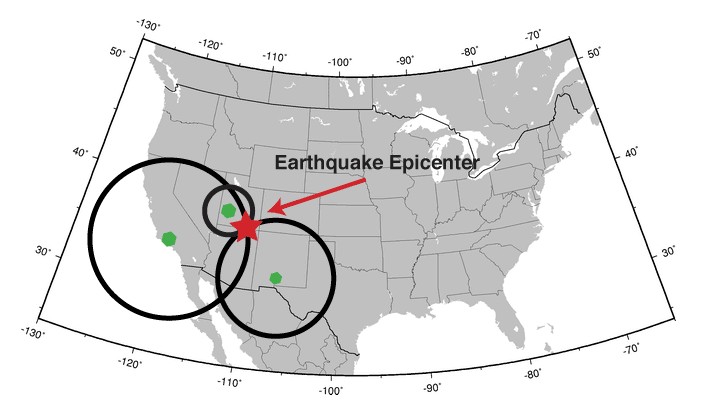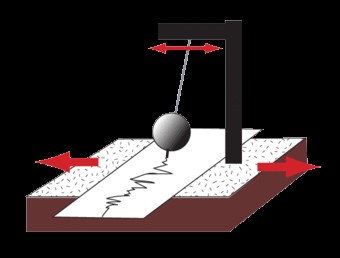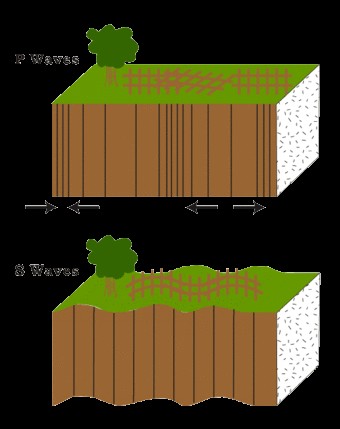Earthquakes travel through the earth in the form of seismic waves. If you’re planning a trip to Vietnam, understanding these natural phenomena can add an interesting dimension to your travel experience. SIXT.VN is here to provide seamless travel solutions, ensuring your journey is as smooth as possible. Let’s delve deeper into how these waves move and what they mean for our planet, offering insights for your travels around Vietnam.
1. What are Earthquakes and How Do They Occur?
Earthquakes occur when two blocks of the earth’s crust suddenly slip past each other along a fault line. The point beneath the Earth’s surface where the earthquake begins is called the hypocenter, while the point directly above it on the surface is known as the epicenter.
Earthquakes often involve foreshocks, smaller tremors preceding the main event, and aftershocks, which are smaller earthquakes that follow the mainshock. Aftershocks can persist for weeks, months, or even years, depending on the magnitude of the main earthquake.
2. What Causes Earthquakes and Where Do They Typically Happen?
Earthquakes are primarily caused by the movement of tectonic plates that make up the Earth’s crust. These plates are constantly moving, and their edges, known as plate boundaries, are often rough.
When these plates move, they can get stuck against each other due to friction. Over time, the pressure builds until it overcomes the friction, causing a sudden release of energy in the form of seismic waves. Most earthquakes occur along these plate boundaries.
 Tectonic Plates Divide Earth's Crust
Tectonic Plates Divide Earth's Crust
The tectonic plates divide the Earth’s crust into distinct “plates” that are always slowly moving. Earthquakes are concentrated along these plate boundaries. (Public domain.)
3. Why Does the Earth Shake During an Earthquake?
The shaking during an earthquake is caused by the release of stored energy in the form of seismic waves. When the friction between the stuck edges of tectonic plates is overcome, the stored energy radiates outward from the fault in all directions, similar to ripples on a pond. These seismic waves travel through the Earth, causing the ground to shake. When these waves reach the Earth’s surface, they shake the ground and anything on it, including buildings and people.
4. How are Earthquakes Recorded and Measured?
Earthquakes are recorded using instruments called seismographs. These instruments produce a recording called a seismogram, which helps scientists measure the size and intensity of the earthquake.
4.1. Seismographs
A seismograph consists of a base firmly set in the ground and a heavy weight that hangs freely. When the ground shakes due to an earthquake, the base of the seismograph shakes as well, but the hanging weight remains relatively still due to inertia. The difference in position between the shaking base and the motionless weight is recorded, providing a measurement of the earthquake’s intensity.
The cartoon sketch of the seismograph shows how the instrument shakes with the earth below it, but the recording device remains stationary (instead of the other way around). (Public domain.)
4.2. Measuring Earthquake Size
The size of an earthquake, known as its magnitude, is determined by analyzing the seismogram recordings. The length and amplitude of the seismic waves recorded on the seismogram indicate the size of the fault and the amount of slip that occurred during the earthquake. A longer and more intense wiggle on the seismogram indicates a larger earthquake. Scientists also consider the intensity of shaking, which varies depending on the location relative to the epicenter.
5. How Do Scientists Determine the Location of an Earthquake?
Scientists determine the location of an earthquake by analyzing the arrival times of different types of seismic waves at various seismograph stations.
5.1. P Waves and S Waves
Seismic waves come in two primary types: P waves (primary waves) and S waves (secondary waves). P waves are faster and travel through both solid and liquid materials, while S waves are slower and can only travel through solid materials. By measuring the time difference between the arrival of P waves and S waves at a seismograph station, scientists can calculate the distance from the station to the earthquake’s epicenter.
5.2. Triangulation
To pinpoint the exact location of the earthquake, scientists use a method called triangulation. This involves using data from at least three seismograph stations. By drawing circles on a map around each station, with the radius of each circle representing the distance from the station to the earthquake, the point where the circles intersect indicates the earthquake’s epicenter.
 Triangulation to Locate Earthquake
Triangulation to Locate Earthquake
Triangulation can be used to locate an earthquake. The seismometers are shown as green dots. The calculated distance from each seismometer to the earthquake is shown as a circle. The location where all the circles intersect is the location of the earthquake epicenter. (Public domain.)
6. Can Earthquakes Be Predicted?
Currently, scientists cannot predict earthquakes with any degree of certainty. While they can identify areas at high risk for earthquakes and estimate the likelihood of future events, predicting the exact time and location of an earthquake remains beyond our capabilities. Research continues in this field, but reliable earthquake prediction remains elusive.
7. Understanding Seismic Waves
Seismic waves are vibrations that travel through the Earth, carrying the energy released during an earthquake. These waves radiate outward from the earthquake’s focus, or hypocenter, in all directions. By studying these waves, scientists can learn a great deal about the Earth’s interior structure and the mechanisms that cause earthquakes.
7.1. Types of Seismic Waves
There are several types of seismic waves, each with distinct properties and behaviors:
- P Waves (Primary Waves): These are the fastest seismic waves and are the first to arrive at seismograph stations. They are compressional waves, meaning they cause particles in the Earth to move back and forth in the same direction as the wave is traveling. P waves can travel through solids, liquids, and gases.
- S Waves (Secondary Waves): These waves are slower than P waves and are the second to arrive at seismograph stations. They are shear waves, meaning they cause particles in the Earth to move perpendicular to the direction the wave is traveling. S waves can only travel through solids.
- Surface Waves: These waves travel along the Earth’s surface and are generally slower than both P and S waves. They are responsible for much of the shaking and damage associated with earthquakes. There are two main types of surface waves:
- Love Waves: These are shear waves that move the ground horizontally, perpendicular to the direction of propagation.
- Rayleigh Waves: These waves produce a rolling motion, similar to waves on the ocean, and can cause significant vertical and horizontal ground motion.
P Waves alternately compress and stretch the crustal material parallel to the direction they are propagating. S Waves cause the crustal material to move back and forth perpendicular to the direction they are travelling. (Public domain.)
7.2. How Seismic Waves Travel
Seismic waves travel through the Earth at different speeds, depending on the type of wave and the properties of the material they are passing through. For example, P waves travel faster through denser materials, while S waves cannot travel through liquids at all.
When seismic waves encounter a boundary between different types of materials, such as the boundary between the Earth’s crust and mantle, they can be reflected or refracted, similar to how light waves behave when they pass through a prism. By studying the patterns of reflected and refracted seismic waves, scientists can learn about the structure and composition of the Earth’s interior.
7.3. Seismic Waves and Earthquake Hazards
Seismic waves are responsible for the ground shaking and other hazards associated with earthquakes. The intensity of ground shaking depends on several factors, including the magnitude of the earthquake, the distance from the epicenter, and the local geological conditions.
In areas with soft or unconsolidated soils, ground shaking can be amplified, leading to greater damage. Seismic waves can also trigger landslides, liquefaction (where saturated soils lose their strength and behave like a liquid), and tsunamis (large ocean waves caused by undersea earthquakes).
8. Earthquake Preparedness: Staying Safe
While earthquakes cannot be predicted, there are steps you can take to prepare for them and minimize the risk of injury or damage. Here are some tips for earthquake preparedness:
- Know the Risks: Find out if you live in an area prone to earthquakes and learn about the potential hazards in your area.
- Develop a Plan: Create an earthquake preparedness plan for your home, school, or workplace. This should include identifying safe spots, establishing communication protocols, and assembling an emergency kit.
- Secure Your Home: Take steps to secure your home against earthquake damage. This may include anchoring furniture, reinforcing walls, and bracing overhead fixtures.
- Prepare an Emergency Kit: Assemble an emergency kit with supplies such as food, water, first aid supplies, a flashlight, a radio, and a whistle.
- Practice Drop, Cover, and Hold On: During an earthquake, drop to the ground, cover your head and neck with your arms, and hold on to a sturdy object until the shaking stops.
- Stay Informed: Monitor news and information from reliable sources, such as government agencies and emergency management organizations.
9. Earthquakes in Vietnam: What to Know
While Vietnam is not located in one of the world’s most seismically active zones, earthquakes do occur in the region. The country is situated near several active fault lines, which can generate earthquakes of varying magnitudes.
9.1. Seismic Activity in Vietnam
Vietnam experiences moderate seismic activity, with most earthquakes occurring in the northern and central parts of the country. According to the Institute of Geophysics under the Vietnam Academy of Science and Technology, Vietnam experiences an average of 2-3 earthquakes of magnitude 4.0 or greater each year.
9.2. Notable Earthquakes in Vietnam
Several notable earthquakes have occurred in Vietnam’s history, including:
- Dien Bien Earthquake (1935): This earthquake, with an estimated magnitude of 6.8, caused significant damage in the Dien Bien region of northern Vietnam.
- Tuan Giao Earthquake (1983): This earthquake, with a magnitude of 6.7, caused widespread damage and casualties in the Tuan Giao district of Dien Bien province.
- Son La Earthquake (2015): This earthquake, with a magnitude of 4.2, caused minor damage in the Son La province of northern Vietnam.
9.3. Earthquake Preparedness in Vietnam
Given the potential for earthquakes in Vietnam, it is important to be prepared. The Vietnamese government has implemented several measures to mitigate earthquake risks, including:
- Seismic Monitoring: The Institute of Geophysics operates a network of seismograph stations to monitor seismic activity throughout the country.
- Building Codes: Vietnam has building codes that require new buildings to be designed to withstand earthquakes.
- Public Education: The government conducts public education campaigns to raise awareness about earthquake risks and preparedness measures.
If you are traveling in Vietnam, it is advisable to familiarize yourself with earthquake safety procedures and follow the guidance of local authorities in the event of an earthquake. SIXT.VN can provide you with up-to-date information and assistance to ensure your safety during your trip.
10. How SIXT.VN Enhances Your Travel Experience in Vietnam
Planning a trip to Vietnam involves more than just understanding seismic activity. It’s about ensuring a smooth, comfortable, and enriching experience. That’s where SIXT.VN comes in.
10.1. Comprehensive Travel Solutions
SIXT.VN offers a complete suite of travel services designed to cater to all your needs in Vietnam. Whether you’re a solo traveler, a couple, a family, or a business traveler, SIXT.VN provides personalized solutions to make your trip unforgettable.
- Tour Consultation: SIXT.VN offers expert tour consultation services to help you create the perfect itinerary tailored to your interests and schedule.
- Airport Transfers: Start your trip stress-free with SIXT.VN’s reliable and convenient airport transfer services.
- Hotel Booking: Find the perfect accommodation with SIXT.VN’s wide selection of hotels, catering to all budgets and preferences.
- Attraction Tickets: Skip the lines and secure your tickets to Vietnam’s top attractions with SIXT.VN.
- Flight Booking: Get the best deals on flights to and from Vietnam with SIXT.VN’s flight booking service.
- Hanoi Tours: Explore Hanoi and its surroundings with SIXT.VN’s expertly curated tour packages.
10.2. Reliable and Convenient Services
SIXT.VN is committed to providing reliable, convenient, and high-quality services to ensure a seamless travel experience. With SIXT.VN, you can:
- Book Online: Easily book all your travel services online through SIXT.VN’s user-friendly website.
- 24/7 Support: Enjoy peace of mind with SIXT.VN’s 24/7 customer support, available to assist you with any questions or concerns.
- Flexible Options: Customize your travel plans with SIXT.VN’s flexible options, allowing you to tailor your trip to your exact needs.
10.3. Why Choose SIXT.VN?
Choosing SIXT.VN for your travel needs in Vietnam offers numerous benefits:
- Expertise: Benefit from SIXT.VN’s deep knowledge and expertise in the Vietnamese travel market.
- Convenience: Save time and effort by booking all your travel services in one place.
- Reliability: Trust SIXT.VN to provide reliable and high-quality services, ensuring a smooth and stress-free trip.
- Personalization: Enjoy personalized travel solutions tailored to your unique interests and needs.
11. Booking Your Trip with SIXT.VN: A Step-by-Step Guide
Booking your dream trip to Vietnam with SIXT.VN is easy and straightforward. Here’s a step-by-step guide to help you get started:
- Visit SIXT.VN: Go to the SIXT.VN website.
- Explore Services: Browse the various travel services offered by SIXT.VN, including tour consultation, airport transfers, hotel booking, attraction tickets, flight booking, and Hanoi tours.
- Select Your Services: Choose the services you need for your trip. For example, if you’re interested in a Hanoi tour, click on the “Hanoi Tours” option.
- Customize Your Trip: Customize your selected services to match your preferences. You can select the duration of your tour, the type of accommodation you prefer, and any additional services you may need.
- Provide Your Details: Fill in your personal details, including your name, contact information, and travel dates.
- Review Your Booking: Double-check all the details of your booking to ensure everything is correct.
- Make Payment: Make your payment securely through SIXT.VN’s online payment gateway.
- Receive Confirmation: Once your payment is processed, you will receive a confirmation email with all the details of your booking.
- Enjoy Your Trip: Get ready to enjoy your amazing trip to Vietnam with SIXT.VN!
12. Staying Safe During Your Travels in Vietnam
While Vietnam is generally a safe country for travelers, it’s always a good idea to take precautions to protect yourself and your belongings. Here are some tips for staying safe during your travels in Vietnam:
- Be Aware of Your Surroundings: Pay attention to your surroundings and be aware of potential risks, such as pickpockets and scams.
- Protect Your Belongings: Keep your valuables safe and secure, and avoid displaying expensive jewelry or electronics in public.
- Use Reliable Transportation: Use reputable transportation services, such as taxis or ride-sharing apps, to get around.
- Be Careful with Food and Water: Drink bottled water and be cautious about eating street food from vendors with questionable hygiene practices.
- Respect Local Customs: Be respectful of local customs and traditions, and dress modestly when visiting religious sites.
- Stay Informed: Stay informed about local news and events, and follow the guidance of local authorities in case of any emergencies.
SIXT.VN is committed to ensuring your safety and well-being during your trip to Vietnam. If you have any concerns or need assistance, don’t hesitate to contact SIXT.VN’s 24/7 customer support team.
13. Essential Vietnamese Phrases for Travelers
Learning a few basic Vietnamese phrases can greatly enhance your travel experience and help you connect with locals. Here are some essential phrases to get you started:
| Phrase | Vietnamese | Pronunciation |
|---|---|---|
| Hello | Xin chào | Sin Chao |
| Thank you | Cảm ơn | Kam uhn |
| You’re welcome | Không có gì | Khong Koh Zee |
| Excuse me | Xin lỗi | Sin Loy |
| How much? | Bao nhiêu? | Bao Nyew? |
| Yes | Vâng | Vung |
| No | Không | Khong |
| I don’t understand | Tôi không hiểu | Toy Khong Hiew |
| Where is the toilet? | Nhà vệ sinh ở đâu? | Nha Vay Sin Uh Dow? |
| Can you help me? | Bạn có thể giúp tôi không? | Ban Koh Tay Gyoop Toy Khong? |
| Do you speak English? | Bạn có nói tiếng Anh không? | Ban Koh Noi Tyeng Anh Khong? |
14. Exploring Hanoi: Must-See Attractions
Hanoi, the capital of Vietnam, is a vibrant city with a rich history and culture. Here are some must-see attractions to include in your itinerary:
- Hoan Kiem Lake: A scenic lake in the heart of Hanoi, surrounded by temples, gardens, and historical buildings.
- Old Quarter: A bustling maze of narrow streets filled with shops, restaurants, and traditional craft workshops.
- Ho Chi Minh Mausoleum: The final resting place of Ho Chi Minh, the iconic leader of Vietnam.
- Temple of Literature: Vietnam’s first university, dating back to the 11th century.
- One Pillar Pagoda: A unique pagoda built on a single pillar in the middle of a lotus pond.
- Water Puppet Theatre: A traditional Vietnamese art form featuring puppets performing on water.
- Hoa Lo Prison: A former prison used by the French colonists to incarcerate Vietnamese revolutionaries.
SIXT.VN offers a variety of Hanoi tours that will take you to these and other fascinating attractions, providing you with an immersive and unforgettable experience.
15. Tips for Planning Your Trip to Vietnam
Planning a trip to Vietnam can be an exciting but also overwhelming task. Here are some tips to help you plan your trip and make the most of your experience:
- Determine Your Budget: Set a budget for your trip and stick to it. Vietnam offers options for all budgets, from budget hostels to luxury hotels.
- Choose Your Destinations: Decide which destinations you want to visit in Vietnam. Popular destinations include Hanoi, Ho Chi Minh City, Ha Long Bay, Hoi An, and Sapa.
- Book in Advance: Book your flights, accommodations, and tours in advance, especially if you’re traveling during peak season.
- Get Travel Insurance: Purchase travel insurance to protect yourself against unforeseen events, such as illness, injury, or travel delays.
- Pack Appropriately: Pack light, comfortable clothing suitable for the tropical climate. Don’t forget to bring sunscreen, insect repellent, and a hat.
- Learn About Local Customs: Familiarize yourself with local customs and traditions to avoid causing offense.
- Be Prepared for the Weather: Vietnam has a tropical climate, so be prepared for hot and humid weather. The rainy season typically lasts from May to October.
- Get a Visa: Check the visa requirements for your nationality and apply for a visa in advance if necessary.
- Learn Some Vietnamese: Learning a few basic Vietnamese phrases can be helpful and will be appreciated by locals.
16. FAQ About Earthquakes and Travel
16.1. Can earthquakes affect my travel plans in Vietnam?
While earthquakes are relatively rare in Vietnam, they can occur. It’s good to stay informed and aware of safety procedures, though the likelihood of significant disruption is low.
16.2. How can I stay safe during an earthquake while traveling?
If an earthquake occurs, drop to the ground, cover your head, and hold on to something sturdy. Stay away from windows and unsecured objects.
16.3. Are there specific regions in Vietnam more prone to earthquakes?
The northern and central parts of Vietnam experience more seismic activity compared to the southern regions.
16.4. What should I include in my travel emergency kit?
Include a flashlight, first-aid kit, water, non-perishable food, and a whistle. Ensure you have copies of important documents and a portable charger for your phone.
16.5. How do I receive updates about potential earthquakes in Vietnam?
Monitor local news and weather updates. Also, ensure your hotel or accommodation has an emergency plan in place.
16.6. Does SIXT.VN provide assistance during natural disasters?
Yes, SIXT.VN offers 24/7 customer support and will assist you with any travel-related issues or emergencies during your trip.
16.7. What are the emergency contact numbers in Vietnam?
The general emergency number is 113 (Police), 114 (Fire), and 115 (Ambulance).
16.8. Can I get travel insurance that covers earthquakes?
Yes, many travel insurance policies cover natural disasters, including earthquakes. Check the policy details to ensure you are covered.
16.9. How do earthquakes travel through different types of materials?
Earthquake waves travel differently depending on the material. P-waves can go through solids, liquids, and gases, while S-waves only travel through solids.
16.10. What is the best way to stay informed about potential travel disruptions?
Keep an eye on local news, weather updates, and follow travel advisories. Also, stay in touch with SIXT.VN for any updates related to your travel plans.
Conclusion: Your Seamless Journey with SIXT.VN
Understanding how earthquakes travel can be fascinating, but ensuring a smooth and safe trip to Vietnam is paramount. SIXT.VN is your trusted partner for comprehensive travel solutions, from personalized tour consultations and airport transfers to hotel and flight bookings. With 24/7 customer support and a commitment to reliability, SIXT.VN makes planning and enjoying your Vietnamese adventure effortless.
Ready to explore the beauty and culture of Vietnam? Contact SIXT.VN today to start planning your dream trip. Let us take care of the details, so you can focus on creating unforgettable memories.
Address: 260 Cau Giay, Hanoi, Vietnam
Hotline/WhatsApp: +84 986 244 358
Website: SIXT.VN

 Cartoon Sketch of Seismograph
Cartoon Sketch of Seismograph  P-Waves and S-Waves in Crust
P-Waves and S-Waves in Crust 

